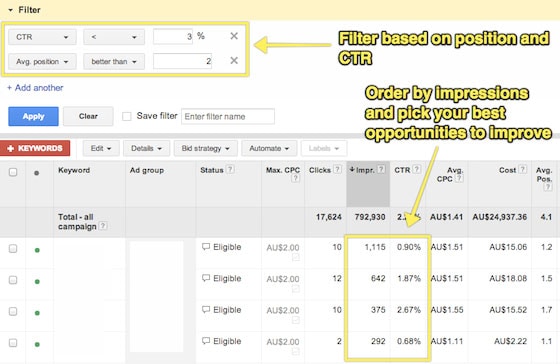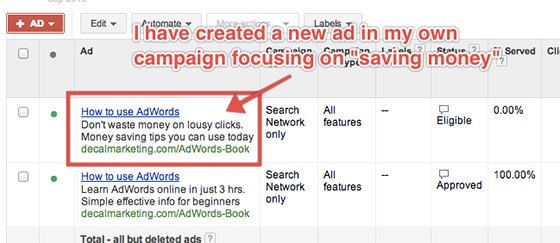
Increasing your click-through rate is the most important thing you can do in your AdWords campaign.
Not only does it get you more traffic, it actually makes that traffic cheaper.Click-Through Rate (CTR) is the single biggest factor in determining Quality Score, and Quality Score is a direct multiplier in determining your Cost Per Click (CPC).
The higher your Quality Score, the lower your CPC by a significant margin. Don’t believe me? Watch Hal Varian, Google’s own Chief Economist explain it.
So how can you increase your CTR? Read on to find out. Hint: Test, test, test.
Step 1: Targeting and Bidding
The most significant increase in CTR you will ever see comes from targeting your ad spend into exact match keywords by analysing your search terms report.
Once you’ve targeted your spending, the next easiest way to increase CTR is to increase your bid.
Your CTR will increase as your position increases on the page. So if your business is so wildly profitable that you’d still be making money even if your CPC doubled, start by looking for the best converting ads and increasing the bid so that your position on the page improves.
But chances are you don’t have so much “spare profit” that you can simply go in, guns blazing, and out-spend your competition. Alternatively, you might find that many of your ads are already in position #1 once you start targeting your spending properly and increasing your bid will not get you any more clicks.
In both these cases, what you need to do is create better ad copy that will improve your CTR. More on that very shortly. First, let’s figure out which ads to optimize.
Step 2: Figuring Out What To Optimize
All smart digital marketers should be addicted to measuring results and using data to make decisions. If you’ve followed the advice in my previous article, you’ve targeted all your spending into ad groups which contain:
- Exactly one ad
- Exactly one exact match keyword
This puts you in the perfect position to A/B test your ads.
Your goal should be to use your highest trafficked ads to determine what language increases CTR, then apply those learnings to other, lower trafficked ads in your campaign.
This gives you some statistically significant results without having to A/B test every individual ad.
To start off with, use a filter to find those ads which have the biggest room for improvement – that is, those with lots of impressions and relatively low click-throughs.
<div class=”blog-photo-annotation”
In order to figure out what a “low CTR” is in the context of your business, you can look at the average for your campaign. It’s tricky, though, because CTR is inextricably linked to position.
You can look at averages on a “per position” basis by running a few filtered queries, and you can also use Quality Score to see which keywords are under-performing. Anything less than QS-7 is likely to have a CTR that is under-performing for its position on the page.
As a sort of rule of thumb, I’d say that the following CTRs would be considered your worst performers:
- 5% with average position better than 2
- 3% with average position better than 3
- 1% for anything else
Note that these rules of thumb apply to exact match keywords only; CTR will vary more widely when you’re bidding on phrase and broad match keywords.
You’ll have to play around a bit with the filters in your own account in order to find your best opportunities for improvement, but the key is that they should be keywords that really match your target market, that have lots of impressions (because that way you can more easily get a statistically significant result) and have a low CTR.
Step 3: A/B Testing Your Ad Copy (Finally!)
Once you’ve identified which ad groups present the best opportunities for improvement, you simply go into each ad group and create a second ad which will “compete” with the first.
If you’re following the process outlined in my first article, chances are your ads all have pretty similar copy in the description lines 1 and 2, with the biggest difference being the headline.
Since your headline will match as closely as possible what the user is searching for, what you should aim to do is create alternate variations of your ads which have the same headline, but different description lines 1 and 2.
Ideally, you want to make the descriptions similar between ad groups as well. This will allow you to identify language that may be applicable on a campaign wide basis (so you can improve your overall VTR without having to run a million different A/B tests).
Okay, so you’re ready to test your ad copy. What do you do? A/B testing is all about gaining insights into customer intent. Calibrate your copy to find out if your customers are:
- Price conscious: Are your customers motivated by price? Try showing a $dollar amount in your ad.
- Service conscious: Have you tried putting a phone number on your ads, either in the ad copy or via an ad extension (see below for more on ad extensions)?
- Quality conscious: Have you tried focusing on the superior quality of your products? Phrases like “long lasting” or “superior construction” indicate that your product may be better value, even if it’s more expensive than your competitors
- Risk averse: Try offering a guarantee, or free shipping/returns to reduce risk.
Here’s an example from my own campaign to sell my AdWords eBook where I’ve created an alternate ad where description lines 1 and 2 focus on the “money conscious” reader:
One thing that you’ll want to do is ensure that you have set your ads to “rotate indefinitely” in AdWords. This means that Google won’t start favoring the ad with the highest click-through rate automatically and allows you to run your experiment for as long as you wish.
You can find out more about how to rotate ads indefinitely in Google’s own support documentation.
And when it comes time to determine if you have a “winning combination,” you can use this cool Split Tester tool from Brian Teasley and Perry Marshall.
If you’re testing the same copy variants across multiple ad groups, you can manually average the clicks and conversion rates for each variant type (or use labels to report on each type of ad more easily) before using the split testing analysis tool above.
From this point on it’s just a long road of testing, adjusting and analysing.
Some Quick CTR Optimization Hacks
Don’t have time to test? Lame excuse. But there are a couple of things you can do to improve the CTR on your ads without A/B testing your copy:
- Use ad extensions: These are cool and they can improve your CTR, but beware: they also increase the “click surface area” of your ad. You might find that ad extension clicks convert differently. Track and measure to see if “all clicks are created equal.” Also, some ad extensions won’t show for ads that aren’t in a top position and you can’t vary the landing page for sitelinks extensions on a per ad group basis. You can read more about ad extensions here.
- Put a full stop at the end of your description line 1. This means your headline and description line 1 will appear on the same line as an “extended headline” (see screenshots below) when your ad is in top position. You can read more on Google’s blog.
Here’s an ad in top position with a full stop at the end of description line 1:
And here’s an ad in top position without a full stop at the end of description line 1:
That said, optimizing your CTR by A/B testing your ads is something you can set up pretty quickly. It’s a good idea to “always be testing” and have a couple of different ads competing against each other in your highest trafficked ad groups.
Depending on how much you’re spending it might take a while to obtain a statistically significant result but if you always have a few tests running you’ll find that you can make optimizations to your ad copy every couple of months and see significant improvements in your campaign over time.
Questions, comments, concerns? Let me know in the comments below!





